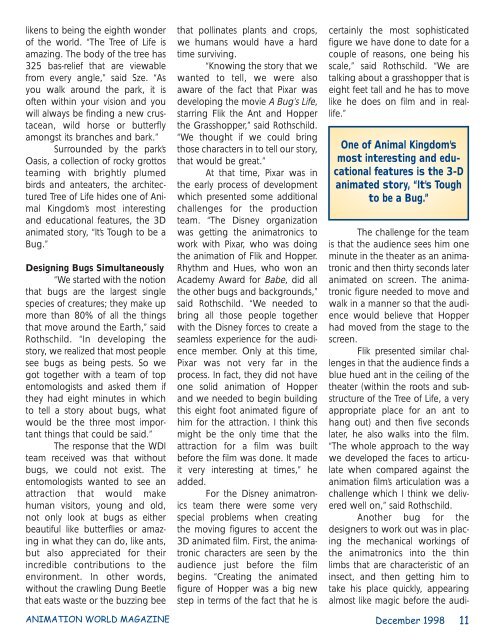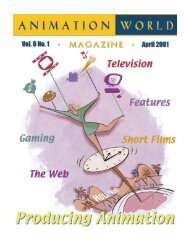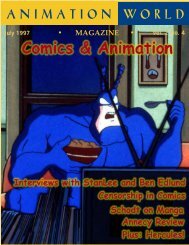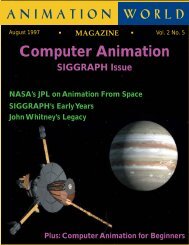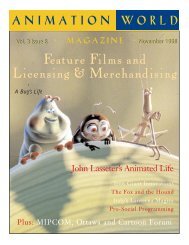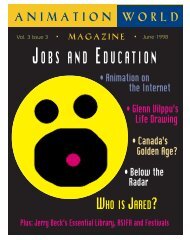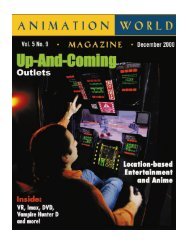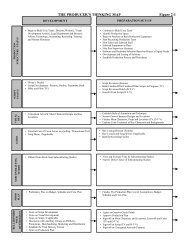Amusement Parks & Family Entertainment Amusement Parks
Amusement Parks & Family Entertainment Amusement Parks
Amusement Parks & Family Entertainment Amusement Parks
You also want an ePaper? Increase the reach of your titles
YUMPU automatically turns print PDFs into web optimized ePapers that Google loves.
likens to being the eighth wonder<br />
of the world. “The Tree of Life is<br />
amazing. The body of the tree has<br />
325 bas-relief that are viewable<br />
from every angle,” said Sze. “As<br />
you walk around the park, it is<br />
often within your vision and you<br />
will always be finding a new crustacean,<br />
wild horse or butterfly<br />
amongst its branches and bark.”<br />
Surrounded by the park’s<br />
Oasis, a collection of rocky grottos<br />
teaming with brightly plumed<br />
birds and anteaters, the architectured<br />
Tree of Life hides one of Animal<br />
Kingdom’s most interesting<br />
and educational features, the 3D<br />
animated story, “It’s Tough to be a<br />
Bug.”<br />
Designing Bugs Simultaneously<br />
“We started with the notion<br />
that bugs are the largest single<br />
species of creatures; they make up<br />
more than 80% of all the things<br />
that move around the Earth,” said<br />
Rothschild. “In developing the<br />
story, we realized that most people<br />
see bugs as being pests. So we<br />
got together with a team of top<br />
entomologists and asked them if<br />
they had eight minutes in which<br />
to tell a story about bugs, what<br />
would be the three most important<br />
things that could be said.”<br />
The response that the WDI<br />
team received was that without<br />
bugs, we could not exist. The<br />
entomologists wanted to see an<br />
attraction that would make<br />
human visitors, young and old,<br />
not only look at bugs as either<br />
beautiful like butterflies or amazing<br />
in what they can do, like ants,<br />
but also appreciated for their<br />
incredible contributions to the<br />
environment. In other words,<br />
without the crawling Dung Beetle<br />
that eats waste or the buzzing bee<br />
that pollinates plants and crops,<br />
we humans would have a hard<br />
time surviving.<br />
“Knowing the story that we<br />
wanted to tell, we were also<br />
aware of the fact that Pixar was<br />
developing the movie A Bug’s Life,<br />
starring Flik the Ant and Hopper<br />
the Grasshopper,” said Rothschild.<br />
“We thought if we could bring<br />
those characters in to tell our story,<br />
that would be great.”<br />
At that time, Pixar was in<br />
the early process of development<br />
which presented some additional<br />
challenges for the production<br />
team. “The Disney organization<br />
was getting the animatronics to<br />
work with Pixar, who was doing<br />
the animation of Flik and Hopper.<br />
Rhythm and Hues, who won an<br />
Academy Award for Babe, did all<br />
the other bugs and backgrounds,”<br />
said Rothschild. “We needed to<br />
bring all those people together<br />
with the Disney forces to create a<br />
seamless experience for the audience<br />
member. Only at this time,<br />
Pixar was not very far in the<br />
process. In fact, they did not have<br />
one solid animation of Hopper<br />
and we needed to begin building<br />
this eight foot animated figure of<br />
him for the attraction. I think this<br />
might be the only time that the<br />
attraction for a film was built<br />
before the film was done. It made<br />
it very interesting at times,” he<br />
added.<br />
For the Disney animatronics<br />
team there were some very<br />
special problems when creating<br />
the moving figures to accent the<br />
3D animated film. First, the animatronic<br />
characters are seen by the<br />
audience just before the film<br />
begins. “Creating the animated<br />
figure of Hopper was a big new<br />
step in terms of the fact that he is<br />
certainly the most sophisticated<br />
figure we have done to date for a<br />
couple of reasons, one being his<br />
scale,” said Rothschild. “We are<br />
talking about a grasshopper that is<br />
eight feet tall and he has to move<br />
like he does on film and in reallife.”<br />
One of Animal Kingdom’s<br />
most interesting and educational<br />
features is the 3-D<br />
animated story, “It’s Tough<br />
to be a Bug.”<br />
The challenge for the team<br />
is that the audience sees him one<br />
minute in the theater as an animatronic<br />
and then thirty seconds later<br />
animated on screen. The animatronic<br />
figure needed to move and<br />
walk in a manner so that the audience<br />
would believe that Hopper<br />
had moved from the stage to the<br />
screen.<br />
Flik presented similar challenges<br />
in that the audience finds a<br />
blue hued ant in the ceiling of the<br />
theater (within the roots and substructure<br />
of the Tree of Life, a very<br />
appropriate place for an ant to<br />
hang out) and then five seconds<br />
later, he also walks into the film.<br />
“The whole approach to the way<br />
we developed the faces to articulate<br />
when compared against the<br />
animation film’s articulation was a<br />
challenge which I think we delivered<br />
well on,” said Rothschild.<br />
Another bug for the<br />
designers to work out was in placing<br />
the mechanical workings of<br />
the animatronics into the thin<br />
limbs that are characteristic of an<br />
insect, and then getting him to<br />
take his place quickly, appearing<br />
almost like magic before the audi-<br />
ANIMATION WORLD MAGAZINE December 1998 11


